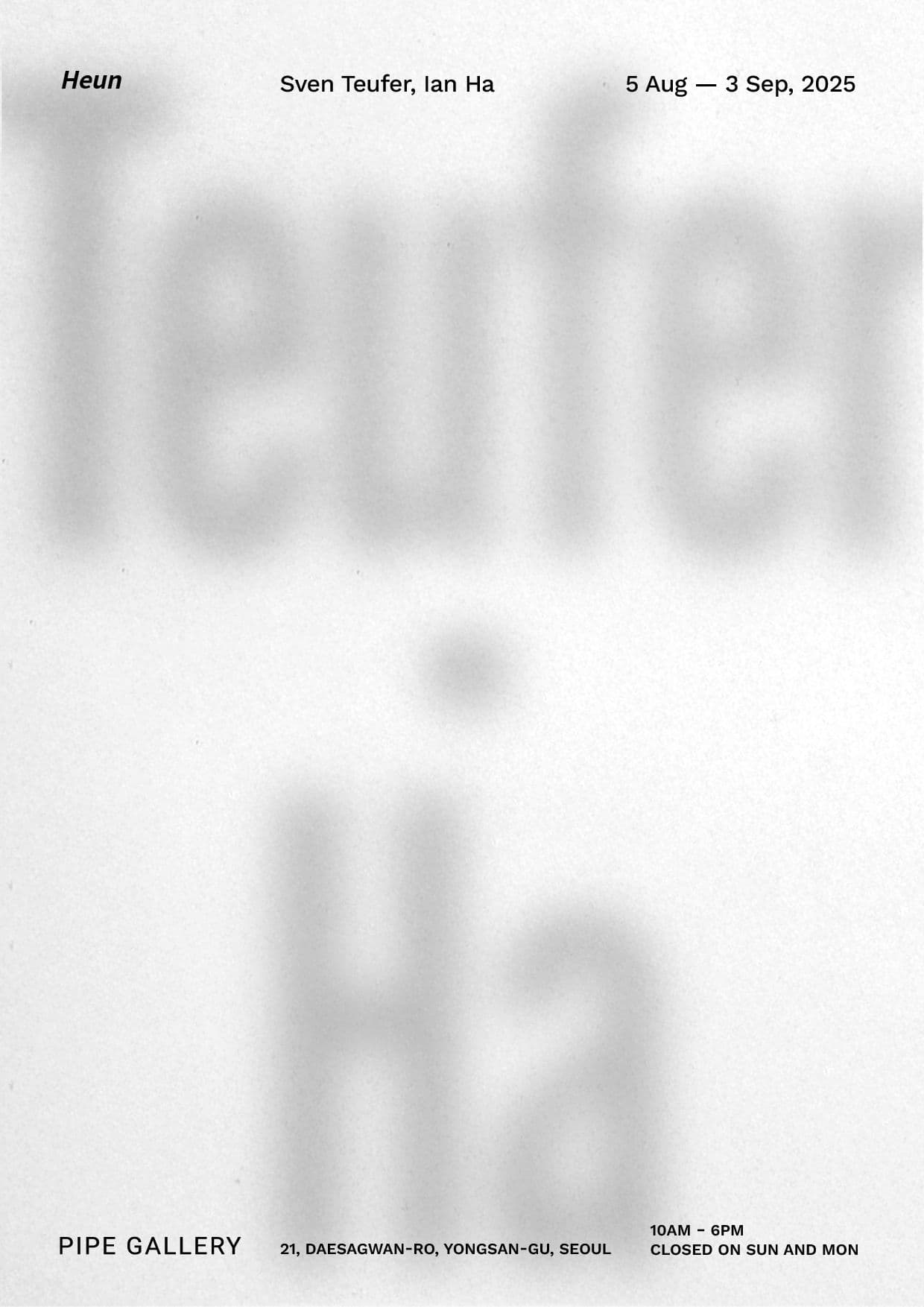
Heun
파이프갤러리는 8월 5일부터 9월 3일까지 이안 하(b.1997)와 스벤 토이퍼(b.1990)의 2인전 《Heun》을 개최한다. 전시 제목 '흔(痕, heun)'은, 사물이나 사건, 존재가 남긴 자취를 의미한다.'흔'은 단순한 물리적 자국을 넘어, 과거의 행위나 존재가 현재에 남긴 물리적·심리적·개념적 흔적을 포괄하며, 시간성과 공간성, 나아가 존재론적 사유를 동반한다. 이번 전시에서의 '흔'은 '덜어냄' 이후에 남겨진 자취, 즉 감축과 소거의 행위 속에서 비로소 드러나는 존재의 증거이자 새로운 시작과 가능성을 의미한다.
이안 하와 스벤 토이퍼는 회화를 작업의 중심에 두고 있음에도 불구하고, 전통적인 재현 방식보다는 지우기와 덜어내기를 통해 이미지를 구성하는 방식을 취한다. 이들의 작업에서 '흔'은 단순히 과거의 잔재가 아닌, 지워진 것의 감각적 잔여이자 그 존재를 증명하는 물리적 증거로서, 마치 침묵 속에서 울리는 여운처럼 화면에 남겨진다. 따라서 이들은 화면 위에 무언가를 덧입히기보다는 비워내는 방식을 통해 회화의 본질적 질문에 응답한다. 이러한 맥락에서 '흔'은 소멸의 결과이면서 동시에 새로운 생성의 출발점이 된다. 종이라는 섬세하고 감응적인 매체는 무엇을 더하고 무엇을 뺄 것인가에 대한 반복적인 선택 과정 속에서 물감이 스며들고 고정되는 물리적 장소가 되며, 감각과 사유가 교차하는 사유의 장으로 기능한다. 특히 의도적으로 남겨진 공백은 단순한 결손이 아니라 새로운 형상의 가능성을 내포한 잠재적 공간이 된다. 이러한 공백은 고정된 의미를 거부하고 관람자의 시선과 해석에 따라 끊임없이 확장되고 재구성된다.
이안 하는 시간의 흐름속에서 사라지거나 잊혀진 과거의 기억과 이미지, 시간의 감각적 흔적을 재구성하며, 존재와 부재가 교차하는 회화적 공간을 구축한다. 북미에서의 유년 시절과 현재 한국과 미국을 오가는 삶 사이의 거리와 시차는 그의 작업에서 중첩되는 이미지로 드러난다. 특히 판화와 회화를 병치하는 기법은 서로 다른 시간성과 공간성이 만나는 지점이 된다. 디아스포라적 경험을 바탕으로 그는 자신의 기억 속 사물의 맥락을 해체하고, 반복과 재배열을 통해 익숙한 이미지를 낯설게 드러냄으로써, 감각적이고 개념적인 '흔'을 회화적 차원에서 시각화한다. 이안의 화면 속 경계적 사물들은 폐쇄와 확장, 실제와 가상 사이에 놓이며, '덜어냄'을 통한 생성, 즉 비워진 여백 속에서 다시 생성되는 의미의 가능성을 탐색한다.
스벤 토이퍼는 '덜어냄'을 통해 생성되는 형상, 그리고 물질성과 비물질성 사이의 경계를 섬세하게 탐색한다. 그는 제한된 형식과 물성을 자발적으로 수용함으로써, 회화적 기교와 붓의 움직임, 그리고 의도적으로 남겨진 공백이 이끄는 형이상학적 사유에 집중한다. 특히 화선지와 한지를 배접한 반투명한 종이는 수정이 불가능한 특성을 지니며, 한 번의 붓질이 곧 흔적으로 남는 긴장된 화면을 형성한다. 이 공백은 단순한 결손이 아닌, 인간 내면의 사유를 반영하는 감축적 공간이 되며, 스벤의 회화는 그러한 공간을 통해 보이지 않는 자연의 힘들과의 관계를 시각화한다. 그는 고정된 화면 안에서 무형의 힘과 감각적 잔향을 응축시키며, 존재와 부재가 교차하는 지점을 탐구한다.
《Heun》은 두 작가가 '덜어냄'과 '비움'의 수행을 통해 존재와 부재, 형상과 공백 사이에 놓인 긴장과 그로부터 파생되는 가능성을 탐색한다. 화면 위에 남겨진 흔적은 단순한 과거의 잔여물이 아니다. 이들의 작업은 지금-여기에서 새로운 해석을 유도하는 열려있는 기호가 되고 전시는 이러한 감각과 사유가 교차하는 공간이 될 것이다.
Pipe Gallery is pleased to presents Heun, a two-person exhibition featuring Ian Ha (b.1997) and Sven Teufer (b.1990), on view from August 5 through September 3. The title Heun (痕) refers to traces left behind by things, events, or beings. Extending beyond mere physical imprints, heun encompasses the residual marks—physical, psychological, or conceptual—of past presences or actions that persist in the present. It evokes temporality and spatiality, and gestures toward ontological reflection. In this exhibition, heun signifies what remains after a process of reduction: the residue that reveals the evidence of existence and gestures toward new beginnings and latent potential.
Although both Ian Ha and Sven Teufer center their practice on painting, they deviate from traditional modes of representation. Instead, they construct images through erasure and subtraction. In their work, heun is not simply the remnant of the past but a sensorial residue of what has been removed—a physical trace attesting to presence, much like an echo resounding in silence. Their practice thus addresses fundamental questions of painting not by layering but by emptying the surface. In this context, heun becomes both the result of disappearance and the point of origin for new formation. Paper—delicate and highly receptive—serves as the physical site where the tension between addition and subtraction unfolds. It becomes a field for thought, where pigment permeates and settles through repeated choices of what to retain and what to erase. In particular, the intentionally left blank spaces do not signify lack but contain the potential for new forms. These voids resist fixed meaning, continually expanding and reorganizing in dialogue with the viewer's gaze and interpretation.
Ian Ha reconstructs sensory remnants of past memories and images—often vanished or forgotten—exploring pictorial space where presence and absence intersect. The temporal and spatial distance between his childhood in North America and his current life between Korea and the United States manifests through layered images. His juxtaposition of printmaking and painting becomes a point where different temporalities and spatialities converge. Grounded in diasporic experience, Ha disassembles familiar visual contexts from memory, reconfiguring them through repetition and reordering. His work renders heun—both sensual and conceptual—visible in painterly terms. The threshold objects in his compositions hover between closure and openness, the real and the virtual, exploring the generative potential of erasure and the meanings that emerge from emptied space.
Sven Teufer delicately investigates the forms born from reduction and the boundaries between material and immaterial. By embracing formal and material constraints, he focuses on painterly gestures, brushwork, and the metaphysical reflections evoked by intentional blankness. His semi-translucent paper—mounted hanji (mulberry paper) and hwaseonji—resists revision, allowing each brushstroke to become an indelible mark, rendering the surface taut with tension. Here, voids are not deficits but spaces of introspection, reflecting interior contemplation. Teufer's paintings visualize the invisible forces of nature through these reductive spaces, condensing intangible energies and sensory echoes within a fixed frame, and probing the juncture of presence and absence.
Heun explores the tension—and the potential it engenders—between 'presence' and 'absence', form and void, through the shared practice of reduction and emptiness. The traces left on the surface are not merely residues of the past. Instead, the works function as open signs that invite interpretation in the here and now. The exhibition becomes a space where sensation and thought intersect.